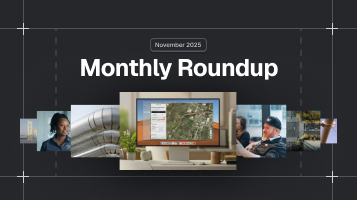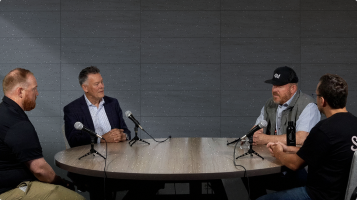Caltrans Cuts Records Research Time by 95% with 4M
Written by
.avif)
Chris Garafola
Published on
April 9, 2024


Table of contents
Customer Profile:
- Project: The Middle-Mile Broadband Initiative
- Project Owner: Caltrans
- Project Phase: Pre-Construction
- Project Delivery Method: CMGC
- Stakeholders: CDT, Granite Construction
- Location: Northern, CA | District 5
Key Results

Straight from the source
Hear what Caltrans Transportation Engineer Caleb Grinager had to say about his experience with 4M's Utility AI Mapping and Analytics Solution.
Project Background
The California Department of Technology (CDT) oversees the Middle-Mile Broadband Initiative — a massive project that involves laying 10,101 miles of fiber optic lines to provide reliable broadband internet access to all Californians. Heading up on-the-ground construction efforts, the California Department of Transportation (Caltrans) is working hard to finish this giant project ahead of a 2026 deadline.
Caltrans contracted with Granite Construction, a U.S. leader in infrastructure construction, and others to undertake on-the-ground efforts. Government projects often demand an “all hands on deck” approach, with multiple engineers deployed to do utility records research and coordination. “Time management is our biggest challenge,” explains Caltrans Transportation Engineer, Caleb Grinager. “It’s a matter of considering the level of importance and effort needed for each task to maintain the schedule and quality of work.”
Challenge: Reduce the Burden of Conventional Research
Utility research — the process of discovering and mapping the network of gas lines, water pipes, and other underground utilities in a given area — is always a challenge. But it’s even harder in a state like California, where sprawling urban areas add up to a dense network of underground infrastructure, each with the potential to become a costly utility strike or delayed project if it goes undetected.
For the Middle-Mile project, Caltrans faced an estimated cost of $11,604 per mile to conduct a utility investigation before breaking ground. The breakdown included 80 hours per mile for records research and field investigation. For a large project of 50 linear miles, the conventional process could take six months or more.
Aware of emerging Utility AI Mapping technology, Caltrans wanted to find a new way forward. “Innovation is a practice we value and strive to integrate into our projects as much as possible,” Grinager says. “We decided to look at an alternative method to help deliver utility information faster.” That’s when Granite Construction introduced Caltrans to 4M Analytics.
Solution: Utility AI Mapping
While the promise of quick-turnaround utility information sounded appealing, Grinager and his colleagues had some concerns about how 4M's Utility AI Mapping and Analytics Solution would work. “We wondered how quickly we would receive the information and how accurate it would be,” he says. Grinager and his team attended a presentation to learn more about 4M’s capabilities. “They walked us through a demonstration of the product, helping us understand the delivered information, the context behind it, and how we could extract it for our use.” Impressed with what they saw, Caltrans gave 4M a try with a 6.7-mile pilot in District 5.
Phase 1: 6.7-Mile Pilot
Deliverables & Highlights
- 5 segments delivered (6.7 miles in total)
- 2 days (Standard)/ 13 days (Advanced) turnaround
- 61 miles of utility lines were mapped
- 28 different utility owners were identified
- 10 abandoned lines were discovered
4M mapped and delivered advanced utility data on five district 5 segments in California. In one of those segments, Highway 9 in Felton, 4M identified and verified an abandoned gas line and an abandoned water line in a single mile using conflated data from 1980s utility maps and images. 4M also identified an undetermined excavation based on visual evidence.



When the initial project concluded, the 4M team consulted with Caltrans engineer Jason Castillo to evaluate the return on investment. “With 4M, our results show a time savings of about 80 - 95% compared to our typical records research and analysis hours per mile,” says Castillo. “4M took us from 80 hours per mile to 13 hours per mile."

Phase 2: Additional 50 Miles Mapped and Delivered
Caltrans decided to use 4M for an additional 50 linear miles, ordering advanced data for 9 miles and Standard data for the rest. 4M delivered all the data in CAD and GIS file formats within about four weeks.
When he reviewed the data, Grinager was impressed. “4M’s product creates the most value in early project planning phases, enabling the ability to get reliable data up front,” he says. “We received useful information about various utilities for a large section of our project — and 4M did it in a fraction of the time compared to our usual research methods.”
Key Results
- 73% cost saving in records research
- 80–95% time savings in record research
- 46% additional utility line coverage
- Up to a 50% reduction in field investigation costs
- 75% of engineering resources liberated to focus on critical design activities
Phase 3: 95% design for a 13-mile area
As Caltrans looked at tackling a third phase of the project, its engineers faced a tough challenge: preparing and submitting a 95% design for a 13-mile area in less than a week. They used 4M to help meet the tight timeline, and we delivered the needed data on time, ready to be uploaded to the layout plans with minimal effort.
Overall, utilizing 4M for record research helped Caltrans accelerate project kickoffs and save more than $100,000 on the project to date. We also achieved incredible efficiency outcomes, delivering the data in less than a week with just one engineer — as opposed to traditional research, which would take six months and four engineers. This not only resulted in a 95% reduction in time but also freed up three engineers to focus on other critical tasks. Moreover, 4M identified 46% more lines missed in previous records, mitigating potential risks that had gone unrecognized.
Looking Ahead
The adoption of 4M is projected to yield a tremendous cumulative cost and time savings for Caltrans. Based on a study using data from the first three projects, 4M estimates that 500 linear miles of research would take 6,667 labor hours with 4M compared to 40,000 using traditional methods.
Traditional utility research would take up to a year for that land area. However, with 4M’s NEW Preliminary Real-Time Data—the first AI-powered utility desk study available in real-time—Caltrans can get instant visibility and access to detailed information on utility lines, their owners, and more across California.

This digital transformation means:
- Access Detailed Utility Data in Real-Time: Caltrans can get access to detailed utility data in real-time, helping them make more informed decisions during the planning stages of construction.
- Liberate Engineers: Caltrans can liberate engineers from mundane record research, freeing them to focus on higher-level tasks.
- Accelerate Planning & Mobilize Field Teams: With instant access to utility data, Caltrans can eliminate wait time and expedite preliminary planning, enabling rapid mobilization of their field teams for on-site verification.
- Mitigation of Unforeseen Risk: Early awareness of undocumented lines will help Caltrans avoid unknowns and costly utility strikes.
“Given the fast-paced nature of our project, 4M helped us overcome the challenge of time management and obtain utility information [quickly]. This allowed us to focus our attention on other important tasks.” -Caleb Grinager, Caltrans Transportation Engineer
With 4M’s Utility AI Mapping on board, Caltrans is empowered to meet the state’s deadline to deliver broadband internet to its residents. “Based on my experience with 4M, I can see this product being used for future projects,” Grinager adds. “This journey has made me more open to innovation than I was before. We decided to pursue a new opportunity and benefited in a significant way. I think other project owners should consider how 4M can help provide invaluable information while saving time and costs.”
Straight from the source
What were the biggest challenges you faced in your role before using 4M?
Caleb Grinager: "The biggest challenge I could think of involved time management. There are typically many tasks, deadlines, and or deliverables that are expected at specific times and therefore require effective prioritization. Time management becomes a key aspect in this because I must consider the level of importance and effort needed to complete each task in order to maintain a timeless schedule and quality of work. It was a little overwhelming at some points, but I would do the best I could to stay on target with each goal."
Why did you choose 4M?
Caleb Grinager: "Innovation is a practice that we value and strive to integrate into our projects as much as possible. We decided that an alternative method to help deliver utility information faster, with relative accuracy and simple integration would be beneficial."
Did you have initial doubts about 4M? Why did you chose to work with us?
Caleb Grinager: "So there were some concerns as to how quickly we would receive this utility information, how accurate it would be when compared to our traditional process, and how easy it would be to include in our plan sets. We also were concerned with how communication support would be accommodated for during the project. 4M was introduced to our team as an alternative for our typical preliminary utility investigating process. We attended a presentation that helped familiarize our team with the capabilities that 4M’s product had. A walkthrough and demonstration of the product. product helped us understand the delivered information, the context behind it, and how we would, how we could extract it for our use. We also discussed the potential time and cost savings from using this product when compared to our own method. Based on this informative presentation and showcasing, we decided that we wanted to use 4M's product for our project."
What were the main challenges that 4M helped you overcome in this project?
Caleb Grinager: "Given the fast paced nature of our product, 4M's product helped us overcome the challenge of time management. This product helped us obtain utility information quicker than we would have without it. This allowed for our plan sheets to progress quicker and therefore allowed us to focus our attention on other important tasks."
How did 4M help you with a significant breakthrough in your project or workflow?
Caleb Grinager: "4M's product provided useful information about various facilities for a large section of our project that we did not have much available data for. A significant amount of time would have been needed to procure this information, which 4M was able to do within a fraction of that time."
Recent blog posts

Our Newsletter
Join 7k infrastructure professionals
Get monthly insights on ways to build smarter, faster and safer with Utility AI.






